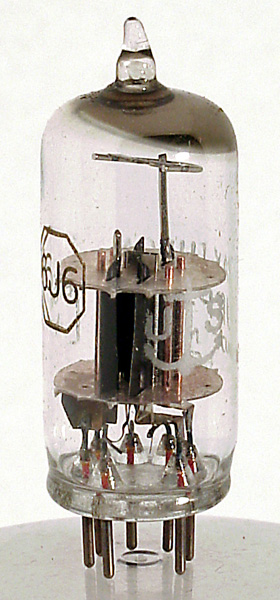|
6J6Sensibly equivalent¶ to:See also:
|
|
|

|
The 6J6 is definitely 'all-American' and the ECC91 is a later copy. We fear much the same is true of many familiar 'British' valve types! - copies of American designs. Fortunately this is not a universal truth, when European industry recovered from the late 1940s onwards much original work was done here in Europe.The move towards all glass construction was a product of many lines of research. The American metal valves used a glass foot, IO base with a spigot hiding the evacuation tube and a metal envelope as did the German footless types. The EE50 and EF50 used all glass construction but encased the valve in an aluminium can and protected the pins with a base and spigot to provide alignment in the socket and protect the evacuation pip. The B7G all-glass form of 'button base' construction is of American origin, dating from the early 1940s. Type 6J6 was one of the earliest B7G valves and probably could not have been made successfully using a conventional 'pinch' structure. Early specimens have a quite distinctive 'waist' where the button base joins the tubular glass envelope. This, and the US Navy WWII 'anchor' logo show that our exhibit is one of the early ones.Once teething troubles had been overcome and B7G mass-production machinery was in place in support of the war effort, B7G types could be made more cheaply than conventional Octals and Loctals so, particularly after the War as military demand diminished and consumer demand rose, this machinery was put to good use making miniature versions of 'ordinary' consumer valve types irrespective of whether the pinchless button construction conferred any technical advantage. One snag was the availability of only 7 pins so some ingenuity was required when miniaturising conventional 8-pin valves. This soon lead to the development of the B9A button base which has remained the world standard ever since.This miniature double triode was used for VHF signal amplification.The construction has a common flattened tube cathode, with the control grids either side. The anodes are U channel sections either side of the central cathode.The thin glass tube envelope is 18 mm diameter and 44 mm high excluding the B7G base pins.References: Data-sheet & 1040. Type 6J6 was first introduced in 1944. See also 1944 adverts. |
Pin Connections
| 1 | 2 | 3 | 4 | 5 | 6 | 7 |  a(2) | a(1) | h | h | g(1) | g(2) | k |
|
|
Absolute Maximum Operating Conditions¶
| Vh | Ah | Va | Vg | mAa | ra | gm | 
| 6.3 | 0.45 | 100 | -0.85 | 8.5 | 7100 | 5.3 |
|
Updated February 02, 2013.
|
|